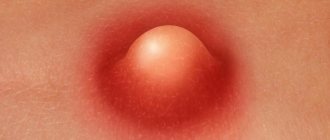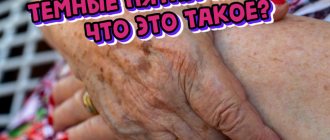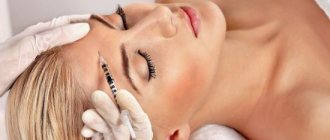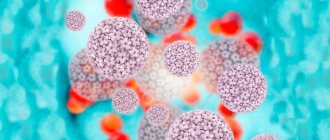Acanthosis nigricans is a dermatological disease characterized by hyperpigmentation and hyperkeratosis of the skin in natural folds. Pathology is rare. According to statistics, it is diagnosed with a frequency of 1% in light-skinned people, and 13.5% in dark-skinned people. Signs of hyperkeratosis and hyperpigmentation are usually localized in the armpits, neck folds and groin. The exact reasons for the development of acanthosis nigricans have not yet been determined, but its connection with malignant processes, disorders of the endocrine system, and also with heredity has been established.
The basis of diagnosis is a biopsy of the affected tissues followed by their examination under a microscope. Treatment of acanthosis nigricans is complex. To stabilize the patient's condition, vitamin complexes, ointments with anti-inflammatory and antiseptic effects, creams to soften rough areas, neurotropic and antibacterial drugs are prescribed.
…
General information
Acanthosis nigricans (ICD-10 code: L83 in Latin - acanthosis nigricans) is hyperpigmentation of the skin, which most often occurs in the folds of the skin - in the axillary area, in the groin, as well as on the neck and other areas.
Most often, acanthosis nigricans - dystrophic papillary pigment changes of the skin is diagnosed in young people - under 40 years of age (with the exception of malignant), suffering from obesity or endocrinopathies, including hypo- and hyperthyroidism , acromegaly , insulin resistance , polycystic ovary syndrome , diabetes mellitus and Itsenko's disease. Cushing .
Treatment
In the presence of keratosis nigricans, treatment should be developed in a comprehensive manner, and tactics are aimed at eliminating the root cause. Also, all patients must be constantly monitored at the dispensary.
If a benign form of keratosis nigra is diagnosed, then the following are prescribed:
- vitamin complexes (complex of vitamins A, B and C, medicines with ginseng and echinacea);
- ointments with anti-inflammatory and antiseptic effects;
- creams to soften and soothe the skin;
- medicines containing zinc;
- biological products;
- for disorders of the thyroid gland - hormonal drugs;
- neurotropic drugs (depending on the course of the disease);
- antibacterial drugs (depending on the course of the disease).
Treatment for acanthosis nigricans involves following a diet in cases where excess weight is a factor in the development of the disease.
If complications occur, cytostatics or aromatic retinoids may be prescribed. The malignant form requires treatment with radiotherapy, chemotherapy or surgery, which is the best option for solving the problem. After surgery and removal of the seal, the patient’s complete recovery is observed.
Pathogenesis
Acanthosis nigricans in humans is characterized by symmetrical hyperpigmented foci of hyperkeratosis and papillomatosis , predominantly affecting skin folds. Initially occurring hyperpigmentation against the background of dryness and roughening of the skin subsequently acquires a grayish-black slate tint, folding of the skin, numerous and small villous and warty formations are formed. The spread is usually gradual and symmetrical over the years, and may be accompanied by dry hair, nail dystrophy, and increased keratinization of the surfaces of the palms and soles. The changes are quite often caused by the long-term effect of insulin on keratinocytes - the binding of insulin molecules on the surface of the epidermis to receptors for insulin-like growth factor.
At its core, malignant acanthosis nigricans is an obligate paraneoplastic dermatosis . Paraneoplastic processes in the body cause skin lesions and a complex of symptoms. The pathogenesis is based on the processes of cellular proliferation of keratinocytes caused by blastoma growth. Chronic inflammation also creates a favorable background for the development of neoplasia. In this case, the inflammatory response is usually directed not only at the tumor, but also at molecules that are expressed in the epithelium and cause paraneoplastic changes.
Classification
Depending on the prognosis, human acanthosis nigricans is divided into clinical forms such as:
- juvenile (primary) - usually diagnosed in childhood or early adolescence and is not associated with endocrine disorders, is considered benign, the rash may regress or remain stationary, is transmitted through an autosomal dominant mode of inheritance;
- medicinal (like all subsequent ones is secondary) - occurs during therapy with diethylstilbestrol , glucocorticoids and overdoses of nicotinic acid ;
- pseudoacanthosis - typical for obese women, more often brunettes, with dark skin, often suffering from ovarian dysfunction, excessive sweating leading to skin trauma; in some cases, regression can be achieved by reducing body weight;
- symptomatic - can be combined with obesity and be associated with hereditary diseases, usually develops against the background of taking estrogens and glucocorticoid hormones, as well as endocrine diseases ( hypothyroidism , type 2 diabetes , Itsenko-Cushing's disease , etc.);
- malignant - observed in people after 40 and develops against the background of oncological processes, accompanied by the production of tumors of various factors that stimulate epidermal growth, most often these are carcinomas of the stomach , cancer of the urinary tract and genital organs, this form of the disease is characterized by clearly pronounced hyperkeratosis of the skin on the palms and soles .
Forecast and prevention of the disease
The prognosis of the disease depends on its form. With pseudoacanthosis and the benign form of acanthosis nigricans, the prognosis is favorable. If improvements are noticed when correcting the conditions that triggered the disease, the symptoms of acanthosis nigricans may regress or disappear completely. In adolescents after puberty, the symptoms of acanthosis also tend to regress or complete recovery occurs.
In the malignant form of acanthosis, the prognosis is most often unfavorable due to the rapid metastasis of the tumor. Even with full treatment, the patient’s life expectancy is no more than two years. Therefore, when you notice the first signs of dark pigmentation on the skin, you must urgently consult a doctor to accurately diagnose the reasons that caused it.
Prevention of the disease consists of regular examinations and visits to a dermatologist. It is also necessary to monitor body weight, regularly monitor blood glucose levels, not self-medicate and not take medications in large doses for a long time.
Causes
Conditions of different origins and pathogenesis can lead to the development of acanthosis nigricans. Although there is an understanding of the mechanisms of skin lesions, the etiogenesis of this dermatosis has not been thoroughly studied. Presumably acanthosis nigricans is provoked by:
- malignant formations;
- insulin resistance;
- hormonal imbalance (hypo- and hyperthyroidism);
- Addison's disease;
- Itsenko-Cushing's disease;
- obesity and polycystic ovary syndrome ;
- taking diethylstilbestrol , glucocorticoids and overdoses of nicotinic acid ;
- autoimmune disorders, such as Hashimoto's thyroiditis ;
- family genetic predisposition.
Etiology
The development of genodermatosis is influenced by various factors. To date, researchers have not been able to find the exact cause of the development of the disease, however, a reliable relationship has been established with the following factors:
- hereditary factor;
- malignant processes and neoplasms;
- changes in the functioning of the endocrine system;
- use of estrogen and glucocorticosteroid hormones;
- taking certain medications.
As for the hereditary factor, the disease can progress if the patient has congenital syndromes accompanied by metabolic dysfunction or mental disorders.
The tumor process provokes acanthosis nigricans with a list of biochemical reactions and immune interactions. Males predominantly suffer from cancer of the stomach, prostate, and pancreas, while females suffer from ovarian and breast cancer. Papillary pigmentary dystrophy of the skin is also observed in the presence of other malignant tumors.
Pathology can provoke hormonal disorders (insulin resistance, hypogonadism, cellulite). When nicotinic acid is consumed in large dosages, the development of the disease is also noted.
Symptoms
The symptom complex of this dermatosis includes:
- local increase in skin pigmentation;
- thickening of the skin in the folds of the body, for example, in the groin and axillary (axillary) area, on the elbows and on the neck;
- unpleasant odor and itching in affected areas;
- strengthening of the skin pattern due to dirty gray papillary growths.
In almost half of the patients, growths with a villous, warty structure can be seen on the oral mucosa and genital organs.
Photo of acanthosis nigricans of the axillary zone
HAIRAN syndrome and acanthosis nigricans in humans
Warty keratinizing growths, as in the photo of acanthosis nigricans in humans, usually occur in places of friction and areas of skin folds, including only the armpits, submammary folds, groin, perineum, but also the neck. Acanthosis can be combined with insulin resistance, hyperandrogenism , amenorrhea and obesity , which together gives HAIRAN syndrome (in English HyperAndrogenic InsulinResistant Acanthosis and Nigricans syndrome ).
Acanthosis nigricans, in the form of HAIRAN syndrome, occurs in approximately 1–3% of women who exhibit signs of masculinization such as changes in male hair type and enlargement of the clitoris.
Acanthosis nigricans in dogs
Canines can also develop acanthosis nigricans in rare cases. In dogs it can be primary or secondary. Primary genetic dermatosis causes bilateral hyperpigmentation, alopecia and skin changes in the axillary and then in the ventral region, develops against the background of inflammatory dermatoses and occurs only in smooth-haired dachshunds aged 6-12 months. Pathology can lead to lichenification and secondary seborrhea , seborrheic odor, secondary bacterial infection, erythema and pain.
Acanthosis nigricans in a dog
The development of secondary anactosis is preceded by any inflammatory processes on the skin of the ventral part of the body. Thus, such hyperpigmentation is post-inflammatory, does not require specific treatment and disappears spontaneously after the inflammatory dermatosis is cured.
If acanthosis in a dog becomes malignant, then symptomatic treatment is ineffective.
Stages of development
Manifestations of acanthosis nigricans usually occur suddenly. Affected areas:
- They are symmetrical.
- Most often they are localized in the bends of the limbs, in the groin and under the armpits. Possible damage to the intergluteal area, back of the neck, and skin under the breasts.
- At first they look like yellow spots.
- Over time they become blackened, sometimes completely dark.
- They become covered with thickened skin and take on a lumpy appearance.
- Covered with papillary growths, similar to genital warts.
- They are extremely rarely detected on mucous membranes.
- Do not cause subjective disturbances in well-being. Itching and burning occur extremely rarely.
The development of acanthosis nigricans makes a person's appearance very unsightly. The body seems dirty and unwashed, which causes psychological discomfort.
Tests and diagnostics
To diagnose acanthosis nigricans in a person, it is necessary to identify 3 symptoms - hyperpigmentation , papillomatosis and hyperkeratosis . To do this, histological examination of biopsy samples is carried out. In this case, in the dermis one can detect uneven hyperplasia, expressed differently in different parts of the epidermis, papillary hypertrophy and a slight perivascular infiltrate of an inflammatory nature.
General blood and urine tests may also be taken, and a general health examination may be prescribed.
Diet for acanthosis nigricans
Diet for obesity
- Efficiency: effect after 2 months
- Timing: constantly
- Cost of products: 1600-1700 rubles. in Week
The basis for the success of treatment – benign processes of hyperpigmentation, papillomatosis and hyperkeratosis of the skin – is weight regulation, normalization of hormonal balance by changing eating habits, including:
- refusal of alcohol, fast food, street food, refined sugar, trans fats;
- adding fiber, cereals, fruit and vegetable salads to the diet, focusing on various types of cabbage and leafy greens;
- adding various seeds and nuts, seafood and avocado, unrefined vegetable oil when preparing dishes;
- drinking natural teas, herbal decoctions and compotes with echinacea;
- minimizing the amount of consumed simple carbohydrates contained in bakery, pasta and confectionery products.











